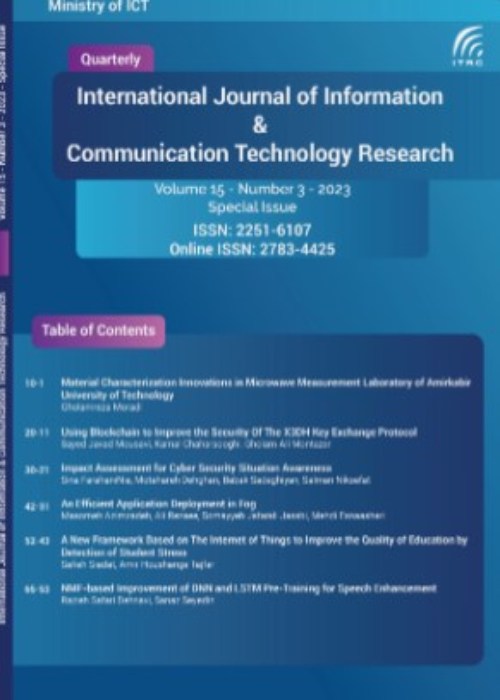فهرست مطالب
International Journal Information and Communication Technology Research
Volume:1 Issue: 2, Spring 2009
- تاریخ انتشار: 1388/01/01
- تعداد عناوین: 7
-
-
Pages 1-10A joint routing and scheduling algorithm for multihop wireless networks, based on a unified convex optimization framework, is proposed. Our approach is novel in that it integrates optimal scheduling with a modified version of distributed minimum delay routing. Accordingly, the algorithm performs packet routing based on a complete multi-hop view of the network and its traffic conditions. This stands in sharp contrast to joint routing and scheduling algorithms, such as the Tassiulas algorithm that rely on per-session queue differential between adjacent nodes for channel scheduling and packet routing. Simulation results illustrate that the proposed algorithm performs much better than Tassiulas, in terms of packet delay and jitter, packet loss and misordering, and energy consumption.Moreover, in terms of capacity region, simulation results do not reflect any noticeable difference between the two algorithms.
-
Pages 11-19In this paper, it is first indicated that a given frequency-selective MIMO channel can be modeled with a matrix that each of its elements is a polynomial of unit delay variable z-1. Then, in order to cancel both inter-channel and inter-symbol interferences, a novel method based on singular value decomposition of polynomial matrices is introduced. In the proposed method, a genetic algorithm is used to find the optimum coefficients of the pre-coder and equalizer filter matrices. Applying these filters to the frequency-selective MIMO channel, converts it to some non-frequency-selective SISO channels. Therefore, both inter-channel and inter-symbol interferences are canceled. Simulation results show that the proposed method has a high performance.
-
Pages 21-27Based on the metal nanodisks arranged in the longitudinal configuration and their coupled localized surface plasmon resonances, a simple optical nanofilter is designed and fabricated using the hole-mask nanolithography technique. The filtering and physical concepts of the nanostructure are discussed using the quasi-static approximation and the circuit model. The optical properties of the proposed nanofilter are investigated using the dispersive finite-difference time-domain method. The spectral response of the filter is tunable in the considered optical range. The model and simulations results agree with the experiments.
-
Pages 29-38In this paper, we introduce two techniques, recently proposed in [1-2], for combination of coding and spread spectrum modulation in wideband Code Division Multiple Access (CDMA) systems. These coding schemes, named as an internal coding, do not require extra bandwidth further than what is needed for a conventional uncoded spread spectrum system. They have been applied to both radio and optical ultra wideband code division multiple access communication systems. Their performance based on both analytical analysis and simulation for various radio and optical applications, and for a variety of single user and multiuser receivers, has been investigated. The results indicate that the internal coded schemes substantially outperform the conventional uncoded scheme, for the same transmitter powers and spectral efficiencies. Also, the various methods for providing multi services and multi rates for the internally coded systems have been introduced and their performance has been investigated.
-
Page 1A novel approach to ultra-wideband (UWB) antenna design is presented which is based on a general description for the geometry of monopole antennas. This general description is capable of producing almost all possible shapes for monopole antennas and it is compatible with different optimization methods. The general description is used for the optimization of rotationally-symmetric monopole antenna with finite ground plane. The optimization of antennas is performed by applying a hybrid procedure, which begins with a global search and completes with a local optimization. The optimization procedure aims at minimizing the reflection from antennas while reducing the distortion of radiated pulses. In some cases, the reduction of variations in the energy pattern is also considered. The numerical results show the reliability and effectiveness of the whole process and considerable improvement in comparison with similar antennas reported in the literature.
-
Page 13Design and implementation procedure of a wideband aperture coupled microstrip antenna in L-band frequency is introduced. To improve radiation performance of the microstrip antenna four structures are proposed. The measurement and simulation results show better performance in terms of matching bandwidth for the structure constructed with air substrate. Experimental results of frequency bandwidth and radiation patterns of the optimum structure are in agreement with the simulation results. The proposed patch antenna creates a directive radiation pattern with a gain of 8.5dB. In addition, it provides a quite large frequency bandwidth of greater than 25%, and F/B better than 15dB as well. This aperture coupled microstrip antenna has been used as an element of 8×1 microstrip array antenna for SSR systems. The array antenna gain, SLL and azimuth HPBW are: 17.5dB, less than 24dB and 10°, respectively.
-
Page 21Formal specification as a precise description of software requirements plays an important role in the software development processes. It can be used as a measurement for validating the artifacts of almost all stages in the development process. Hence, making effort on validating the correctness of the formal specification against the requirements in the very early stages of development is of a high value. Extracting prototype from formal specification can be a kind of such a validation. In this article, we propose a translation set of rules for building executable prototypes written in SetL2 language from formal specification in Z formal language. Then, we investigate the correctness of the translation with help of some lemmas based on weakest precondition predicate transformer and refinement relationship.


